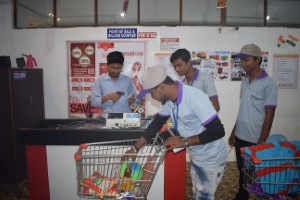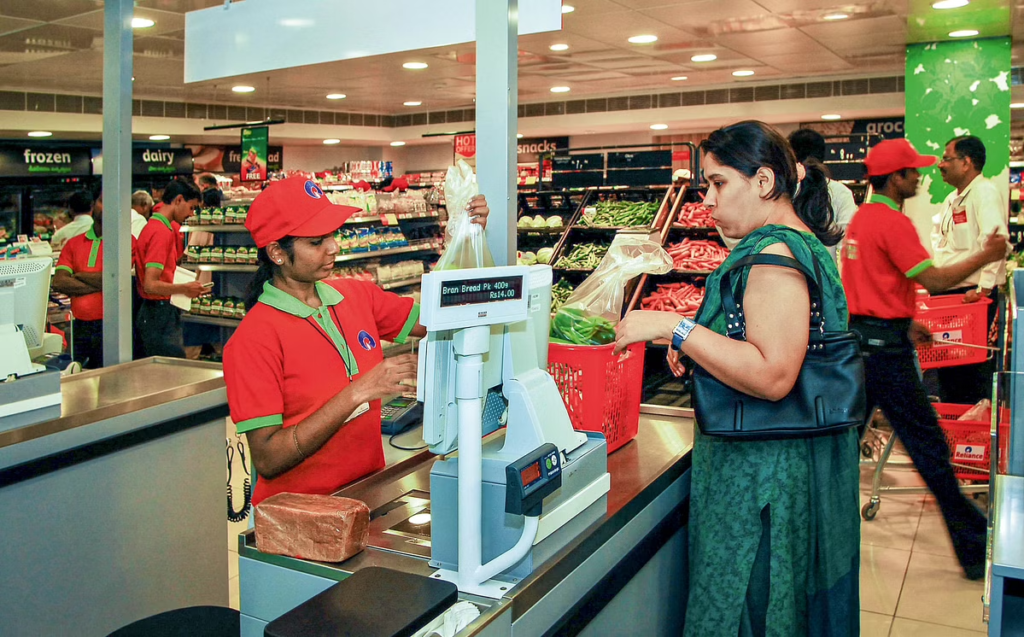Retail Trainee Associate ( 1 years course)
Retail Trainee Associate click here
Retail Trainee Associate
Brief Job Description
Individuals in this position display merchandise and interact with customers to understand their needs to
service them with sales of relevant product offerings whilst working cordially within the team and retail
organization.

Personal Attributes
The individual needs to be physically fit to withstand working in a retail environment whilst being customer
responsive. He/she would need good interpersonal and listening skills.
To display stock to promote sales
Description
This OS describes the skills and knowledge required to effectively display stock to promote sales.
Elements and Performance Criteria
Prepare display areas and goods in a retail store
To be competent, the user/individual on the job must be able to:
PC1. identify the need for the display in relation to stock, space, position of the display and dates.
PC2. check that the display area is the right size and report any concerns promptly.
PC3. gather the materials, equipment and stock needed for the display and check that they are
clean, safe and in good working order.
PC4. follow company procedures for clearing, cleaning and preparing the display area before use.
Set up and dismantle displays in a retail store
To be competent, the user/individual on the job must be able to:
PC5. set up and dismantle the display safely, in line with plans and within the time allowed.
PC6. check that the display is clean, tidy and safe for use.
PC7. check that the display has the levels of stock needed.
PC8. clean and store equipment and excess materials; get rid of waste safely, correctly and
promptly.
Label displays of stock in a retail store
To be competent, the user/individual on the job must be able to:
PC9. check requirements for labelling stock.
PC10. check information on the label is clear, accurate and legal before starting to label stock.
PC11. report promptly any information on labels that may need changing.
PC12. attach the right labels to the right products.
PC13. position labels so that they are securely fastened and customers can see them clearly.
PC14. complete labelling within the time allowed.
Knowledge and Understanding (KU)
The individual on the job needs to know and understand:
KU1. setting up displays as per the health, safety and environmental standards.
KU2. following store procedures for display requirements for stock, space, position of the display &
dates.
KU3. meeting Legal or Statutory requirements
KU4. cleaning and storing materials and equipment used in displays and getting rid of waste safely
KU5. using labelling materials and equipment efficiently and effectively
Generic Skills (GS)
User/individual on the job needs to know how to:
GS1. complete documentation accurately
GS2. write simple reports when required
GS3. read information accurately
GS4. read and interpret data sheets
GS5. follow instructions accurately
GS6. use gestures or simple words to communicate where language barriers exist
GS7. use questioning to minimise misunderstandings
GS8. display courteous and helpful behaviour at all times
GS9. make appropriate decisions regarding the responsibilities of the job role
GS10. plan and schedule routines
GS11. build relationships with internal and external customers
GS12. respond to breakdowns and malfunction of equipment
GS13. respond to unsafe and hazardous working conditions
GS14. respond to security breaches
To plan and prepare visual merchandising displays
Description
This OS describes the skills and knowledge required to effectively plan and prepare visual merchandising
displays
Elements and Performance Criteria
Interpret design briefs for retail displays
To be competent, the user/individual on the job must be able to:
PC1. identify the purpose, content and style of the display.

PC2. identify the equipment, materials, merchandise and props needed to create and install the
display and the dates for completing it.
PC3. evaluate whether the place to put the display is likely to fulfil the design brief.
PC4. create new and effective ways of improving the visual effect, within his/her limits of design
brief, companys visual design policies and authority.
Get hold of merchandise and props to be featured in retail displays
To be competent, the user/individual on the job must be able to:
PC5. confirm that the features of merchandise and props shown in the design brief are those most
likely to attract customers attention.
PC6. identify other merchandise and props when those originally specified are not available or not
suitable, and agree the selections with the right person.
PC7. verify arrangements for delivery of merchandise & props with the right people, allowing
enough time for deliveries to arrive before display must be installed.
PC8. check the progress of deliveries and take suitable action if delays seem likely.
PC9. update stock records to account for merchandise on display.
Knowledge and Understanding (KU)
The individual on the job needs to know and understand:
KU1. Role of displays in marketing, promotional and sales campaigns and activities.
KU2. Importance and content of the design brief
KU3. The design brief to identify what you need for the display.
KU4. The company policies for visual design.
KU5. The role of displays in marketing, promotional and sales campaigns and activities.
KU6. Using the design brief to identify what you need for the display.
KU7. Merchandiser or buyer who needs to be consulted about merchandise and props.
KU8. Arranging delivery of merchandise and monitor the progress of deliveries.
KU9. Updating stock records to account for merchandise on display.
KU10. Different approaches to designing displays for different types of merchandise, and why these
are effective .
KU11. Evaluating the potential places to put the display as per the design brief.
KU12. Light, colour, texture, shape and dimension combined to achieve the effects.
KU13. Assessing the potential of places for displays to meet the design brief.
Generic Skills (GS)
User/individual on the job needs to know how to:
GS1. Complete documentation accurately
GS2. Write simple reports when required
GS3. Read information accurately

GS4. Read and interpret data sheets
GS5. Follow instructions accurately
GS6. Use gestures or simple words to communicate where language barriers exist
GS7. Use questioning to minimise misunderstandings
GS8. Display courteous and helpful behaviour at all times
GS9. Make appropriate decisions regarding the responsibilities of the job role
GS10. Plan and schedule routines
GS11. Build relationships with internal and external customers
GS12. Respond to breakdowns and malfunction of equipment
GS13. Respond to unsafe and hazardous working conditions
GS14. Respond to security breaches
To Dress Visual Merchandising Displays
Description
This OS describes the skills and knowledge required to effectively dress visual merchandising displays.
Elements and Performance Criteria
Dress in-store displays based on guidelines
To be competent, the user/individual on the job must be able to:
PC1. use the design brief to identify the focal points of the display.
PC2. choose shapes, colours and groupings that are suited to the purpose and style of the display.
PC3. create displays that achieve the required visual effect and are consistent with the companys
visual design policy.
PC4. position merchandise, graphics and signs in ways that promote sales.
PC5. check that lighting is installed in line with the design brief.
PC6. check that the finished display meets health and safety guidelines and legal requirements.
Dress window displays based on guidelines
To be competent, the user/individual on the job must be able to:
PC7. position merchandise, graphics & signs according to guidelines & in ways that attract
attention & interest of customers & give customers information they need.
PC8. group merchandise appropriately for the purpose & style of display, the selling features of
merchandise & the visual effect needed under the design brief.
PC9. make sure that lighting is installed in line with lighting requirements.
Evaluate and improve retail displays
To be competent, the user/individual on the job must be able to:
PC10. check that all the parts of the display are suitable for the purpose of the display and meet
requirements.
PC11. check that the display meets requirements for easy access, safety and security.
PC12. identify safety and security risks to the display and choose suitable ways of reducing risks.
PC13. consider how the display looks from all the directions from which customers will approach it.
PC14. encourage colleagues to provide constructive comments about the display.
PC15. promptly make any adjustments that he/she is authorised to make and that are needed to
achieve the visual effect and to make the display safe and secure.
PC16. regularly check the displays visual effect.
PC17. promptly report to the right person any problems and risks that he/she is not responsible for
sorting out himself/herself.
Knowledge and Understanding (KU)
The individual on the job needs to know and understand:
KU1. creating and using focal points within a display.
KU2. putting together merchandising displays for use inside the store.
KU3. dressing mannequins, busts and other props.
KU4. displaying different types of merchandise.
KU5. choosing a suitable type of grouping.
KU6. using different types, directions and levels of light to create atmosphere.
KU7. achieving add-on sales and why this is important.
KU8. installing creative displays and awareness of trends.
KU9. different approaches to displaying merchandise and choosing the best approach.
KU10. props, prototypes, dressings and fixtures creating visual effects.
KU11. health and safety guidelines for displays.
KU12. identifying the selling features of merchandise to be used in displays.
KU13. lighting window displays and who in your store is responsible for installing lighting.
KU14. the legal requirements which apply to pricing and ticketing.
KU15. the companys visual design and merchandising policies.
KU16. reporting arrangements for sorting out problems and reducing risks.
KU17. evaluating the visual effect of displays.

KU18. making adjustments and improvements to displays.
KU19. using scale when creating visual effects.
KU20. dressing techniques for different types of merchandise.
KU21. different purposes of displays and their use in visual merchandising.
KU22. choosing and combining dimension, shape, colour, texture and lighting to create the visual
effect you need from a display.
Generic Skills (GS)
User/individual on the job needs to know how to:
GS1. complete documentation accurately
GS2. write simple reports when required
GS3. read information accurately
GS4. read and interpret data sheets
GS5. follow instructions accurately
GS6. use gestures or simple words to communicate where language barriers exist
GS7. use questioning to minimise misunderstandings
GS8. display courteous and helpful behaviour at all times
GS9. make appropriate decisions regarding the responsibilities of the job role
GS10. plan and schedule routines
GS11. build relationships with internal and external customers
GS12. respond to breakdowns and malfunction of equipment
GS13. respond to unsafe and hazardous working conditions
GS14. respond to security breaches
To Dismantle and Store Visual Merchandising Displays
Description
This OS describes the skills and knowledge required to effectively dismantle and store visual
merchandising displays.
Elements and Performance Criteria
Dismantle retail displays
To be competent, the user/individual on the job must be able to:
PC1. dismantle displays safely.
PC2. protect the parts of the display from being damaged during dismantling.
PC3. return the parts of the display to the appropriate places promptly and, if needed, in a
saleable condition.
PC4. get rid of unwanted materials safely and keep accurate records of this if needed.
PC5. clean display sites and parts using safe and approved cleaning materials and equipment.
Store equipment, props and graphics for retail displays
To be competent, the user/individual on the job must be able to:
PC6. work out accurately the storage space required.
PC7. identify the protective packaging he/she needs and the security measures that need to be in
place.
PC8. store items in suitable places and with clear and accurate labels.
PC9. keep accurate and up-to-date records of items in storage.
PC10. identify damaged items, missing items and dangers and risks to health and safety, and
report these promptly to the right person.
PC11. check that storage facilities and items in storage are clean, safe, secure and accessible only
to those with a right to them.
Knowledge and Understanding (KU)
The individual on the job needs to know and understand:
KU1. dismantling displays safely.
KU2. protecting the parts of displays from being damaged during dismantling.
KU3. identifying unwanted materials and how to get rid of them safely.
KU4. where to return the parts of display to.
KU5. identifying safe and approved cleaning materials and equipment to use.
KU6. working out the storage space needed.
KU7. identifying requirements for protective packaging and security measures.
KU8. labelling items accurately.
KU9. keeping records of items and where to store them.
KU10. items that need to be stored.
KU11. dangers and risks to health, safety and security in relation to storage facilities and stored
items.
KU12. reporting dangers and risks to the concerned
KU13. techniques for cleaning display sites and parts safely and thoroughly.
KU14. checking the condition of items.
KU15. dealing with items that need repair.
KU16. store items securely.
Generic Skills (GS)
User/individual on the job needs to know how to:
GS1. complete documentation accurately
GS2. write simple reports when required
GS3. read information accurately
GS4. read and interpret data sheets
GS5. follow instructions accurately
GS6. use gestures or simple words to communicate where language barriers exist
GS7. use questioning to minimise misunderstandings
GS8. display courteous and helpful behaviour at all times
GS9. make appropriate decisions regarding the responsibilities of the job role
GS10. plan and schedule routines
GS11. build relationships with internal and external customers
GS12. respond to breakdowns and malfunction of equipment
GS13. respond to unsafe and hazardous working conditions
GS14. respond to security breaches
To Prepare Products for Sale
Description
This OS describes the skills and knowledge required to effectively prepare products for sale.
Elements and Performance Criteria
Prepare products for selling to customers
To be competent, the user/individual on the job must be able to:
PC1. check that all expected items and parts of the product are in the package.
PC2. remove all unwanted packaging and safely get rid of waste.
PC3. gather the tools he/she needs for putting products together.
PC4. use safe work methods and follow manufacturers instructions when putting products together.
PC5. check that products have been assembled correctly and can be used safely.
PC6. ask the right person for help when products are proving difficult to put together.
PC7. check regularly that products on display are in a satisfactory condition.
PC8. promptly remove damaged products from display and follow company procedures for dealing
with them.
Knowledge and Understanding (KU)
The individual on the job needs to know and understand:
KU1. products he/she is responsible for preparing for sale.
KU2. where to put products together and where to put them once they are assembled.
KU3. working safely when putting products together for sale.
KU4. checking that products have been correctly put together and are safe to display.
KU5. whom to approach for help when products are proving difficult to put together.
KU6. company quality standards for products on display.
KU7. checking the condition of products on display.
KU8. dealing with products that are damaged.
KU9. tools to be used to put products together.
KU10. getting rid of unwanted packaging and waste.
Generic Skills (GS)
User/individual on the job needs to know how to:
GS1. complete documentation accurately
GS2. write simple reports when required
GS3. read information accurately
GS4. read and interpret data sheets
GS5. follow instructions accurately
GS6. use gestures or simple words to communicate where language barriers exist
GS7. use questioning to minimise misunderstandings
GS8. display courteous and helpful behaviour at all times
GS9. make appropriate decisions regarding the responsibilities of the job role
GS10. plan and schedule routines

GS11. build relationships with internal and external customers
GS12. respond to breakdowns and malfunction of equipment
GS13. respond to unsafe and hazardous working conditions
GS14. respond to security breaches
To promote Loyalty Schemes to Customers
Description
This OS describes the skills and knowledge required to promote loyalty schemes to customers.
Elements and Performance Criteria
Explain to customers the features and benefits of the loyalty scheme
To be competent, the user/individual on the job must be able to:
PC1. take suitable opportunities to ask customers if they are members of the loyalty scheme and
whether they are interested in joining.
PC2. explain clearly and accurately to customers how joining the scheme would benefit them,
including any current special offers relating to the scheme.
PC3. respond positively to any questions or objections that the customer raises.
PC4. provide relevant information to the customer to help them decide whether to join the
scheme.
PC5. treat the customer politely at all times and in a way that promotes goodwill.
Gain customer commitment to the loyalty scheme
To be competent, the user/individual on the job must be able to:
PC6. recognise accurately when customers are interested in joining the scheme.
PC7. take opportunities to ask customers who are showing signs of interest to sign up for the
scheme.
PC8. fill in the membership application accurately with the customer, using the information they
provide.
PC9. give the customer proof of their membership.
PC10. check with the customer that their details, as shown on the membership documentation, are
correct.
PC11. give application forms to customers who show interest but are not willing to join the scheme
then and there.
Knowledge and Understanding (KU)
The individual on the job needs to know and understand:
KU1. features and benefits of the companys loyalty scheme.
KU2. sources of information about the scheme that you can use or tell the customer about.
KU3. loyalty schemes that are important in achieving the companys commercial aims.
KU4. specific offers currently available to scheme members.
KU5. gaining customers attention and interest.
KU6. using suitable questions to gain information about the customer and their interest in joining
the scheme.
KU7. dealing with frequently raised questions and objections in relation to the scheme.
KU8. recognising signals that customers are interested in joining the loyalty scheme.
KU9. asking customers to sign up for scheme in a way that encourages them to co-operate
willingly.
KU10. the layout of the membership application form, the questions it asks, and how to fill in the
form accurately.
KU11. the proof of membership the company provides.
KU12. correcting or replacing incorrect proof of membership.
KU13. financial benefit accrued by a customer through loyalty schemes
Generic Skills (GS)
User/individual on the job needs to know how to:
GS1. complete documentation accurately
GS2. write simple reports when required
GS3. read information accurately
GS4. read and interpret data sheets
GS5. follow instructions accurately
GS6. use gestures or simple words to communicate where language barriers exist
GS7. use questioning to minimise misunderstandings
GS8. display courteous and helpful behaviour at all times
GS9. make appropriate decisions regarding the responsibilities of the job role
GS10. plan and schedule routines
GS11. build relationships with internal and external customers
GS12. respond to breakdowns and malfunction of equipment
GS13. respond to unsafe and hazardous working conditions
GS14. respond to security breaches
GS15. determine impact of the loyalty schemes to the benefit of the company.
To Keep the Store Secure
Description
This OS describes the skills and knowledge required to keep the store secure.
Elements and Performance Criteria
Identify and report security risks
To be competent, the user/individual on the job must be able to:
PC1. notice and correctly identify security risks.
PC2. follow company procedures for reporting security risks.
PC3. report security risks to the right people promptly and accurately.
PC4. follow company procedures for preventing security risks while working.
PC5. notice where stock may have been stolen and tell the right person about it.
Knowledge and Understanding (KU)
The individual on the job needs to know and understand:
KU1. workplace security matters.
KU2. what can happen to him/her and to the company, if the store is not kept secure.
KU3. helping to keep the workplace secure by noticing and reporting security risks.
KU4. the types of security risk he/she needs to be alert for, including: shoplifting, theft by staff,
aggressive customers, vandalism, terrorist activity.
KU5. identifying security risks.
KU6. situations that can make him/her less alert for security risks, and how to deal with these
situations.
KU7. reporting security risks promptly and accurately.
KU8. whom to report security risks to and how to communicate these risks.
KU9. reasons why he/she should not take on more responsibility than he/she is authorised to when
faced with security risks, including: personal safety, legal considerations & company policy.
KU10. activating all the loss prevention and security devices.
KU11. securing all the security alarms.
KU12. deactivating the loss prevention & security devices.
Generic Skills (GS)
User/individual on the job needs to know how to:
GS1. complete documentation accurately
GS2. write simple reports when required
GS3. read information accurately
GS4. read and interpret data sheets
GS5. follow instructions accurately
GS6. use gestures or simple words to communicate where language barriers exist
GS7. use questioning to minimise misunderstandings
GS8. display courteous and helpful behaviour at all times
GS9. make appropriate decisions regarding the responsibilities of the job role
GS10. plan and schedule routines
GS11. build relationships with internal and external customers
GS12. respond to breakdowns and malfunction of equipment
GS13. respond to unsafe and hazardous working conditions
GS14. respond to security breaches
To Maintain Health and Safety
Description
This OS describes the skills and knowledge required to maintain health and safety.
Elements and Performance Criteria
Identify and report accidents and emergencies
To be competent, the user/individual on the job must be able to:
PC1. notice and correctly identify accidents and emergencies.
PC2. get help promptly and in the most suitable way.
PC3. follow company policy and procedures for preventing further injury while waiting for help to
arrive.
PC4. act within the limits of his/her responsibility and authority when accidents and emergencies
arise.
PC5. promptly follow instructions given by senior staff and the emergency services.
Protect health and safety as you work
To be competent, the user/individual on the job must be able to:
PC6. follow company procedures and legal requirements for reducing health and safety risks as
far as possible while working.
PC7. use safety equipment correctly and in the right situations.
PC8. get advice and help from the right people when he/she concerned about his ability to work
safely.
PC9. take suitable safety measures before lifting to protect himself/herself and other people.
Lift and handle goods safely
To be competent, the user/individual on the job must be able to:
PC10. use approved lifting and handling techniques.
PC11. check that any equipment he/she needs to use is fit for use.
PC12. use lifting and handling equipment in line with company guidelines and manufacturers
instructions.
PC13. plan a safe and efficient route for moving goods.
PC14. make sure that he/she understands his/her own responsibilities when he/she asks others to
help in lifting and handling operations.
Knowledge and Understanding (KU)
The individual on the job needs to know and understand:
KU1. the types of accident and emergency that tend to happen in stores and why they happen.
KU2. getting help in the event of an accident or emergency.
KU3. action he/she can safely and usefully take while waiting for help to arrive.
KU4. health and safety risk that can arise in a store environment.
KU5. company procedures and legal requirements for reducing health and safety risks as far as
possible while working.
KU6. following health and safety procedures.
KU7. safety equipment to be used and why it is required.
KU8. what he/she can lift safely.
KU9. weight of the loads he/she has to lift.
KU10. company guidelines for not lifting more than safe loads.
KU11. planning his/her route when moving goods including the types of obstacles to look for and
how to remove or avoid them.
KU12. company guidelines and manufacturers instructions for using lifting and handling equipment.
KU13. approved techniques for safe handling and lifting.
KU14. approved procedures for using safety equipment.
Generic Skills (GS)
User/individual on the job needs to know how to:
GS1. complete documentation accurately
GS2. write simple reports when required
GS3. read information accurately
GS4. read and interpret data sheets
GS5. follow instructions accurately
GS6. use gestures or simple words to communicate where language barriers exist
GS7. use questioning to minimise misunderstandings
GS8. display courteous and helpful behaviour at all times
GS9. make appropriate decisions regarding the responsibilities of the job role
GS10. plan and schedule routines
GS11. build relationships with internal and external customers
GS12. respond to breakdowns and malfunction of equipment
GS13. respond to unsafe and hazardous working conditions
GS14. respond to security breaches
To Keep the Store Clean and Hygienic
Description
This OS describes the skills and knowledge required to keep the store clean and hygienic.
Elements and Performance Criteria
Keep work surfaces clean
To be competent, the user/individual on the job must be able to:
PC1. get the equipment and materials that are suitable for the surfaces that need cleaning.
PC2. safely position the cleaning equipment and materials and any items he/she must move.
PC3. keep the risk of spillages to a minimum and clean up any spillages promptly and thoroughly.
PC4. get rid of rubbish and waste promptly and safely.
PC5. disturb other people as little as possible while cleaning.
PC6. check that surfaces are thoroughly clean.
PC7. store cleaning equipment and materials correctly and promptly when he/she has finished
cleaning.
Protect health and safety as you work
To be competent, the user/individual on the job must be able to:
PC8. use suitable equipment to tidy work areas.
PC9. check that equipment is safe to use before starting to use it.

PC10. get rid of waste and litter safely and in line with company procedures.
PC11. disturb other people as little as possible while getting rid of waste and litter.
PC12. store equipment correctly and promptly after use.
PC13. wear protective clothing that is clean and suitable for the work he/she needs to do.
Maintain personal hygiene
To be competent, the user/individual on the job must be able to:
PC14. correctly dispose of used clothing and products.
PC15. use effective practices and techniques for keeping his/her hair, skin and nails clean enough
for the work he/she does.
Knowledge and Understanding (KU)
The individual on the job needs to know and understand:
KU1. health and safety risks posed by spillages.
KU2. cleaning up spillages promptly.
KU3. following procedures laid by Health Regulations when carrying out routine cleaning and
when dealing with spillages.
KU4. cleaning up spillages thoroughly.
KU5. getting rid of rubbish and waste promptly and safely.
KU6. not disturbing others as much as possible while cleaning.
KU7. company standards for clean work surfaces.
KU8. why work areas should be kept free of waste and litter, including health and safety reasons.
KU9. safe methods for getting rid of waste and litter.
KU10. where equipment is stored.
KU11. putting equipment away promptly after use.
KU12. effective cleaning practices and techniques for keeping ones own hair, skin and nails clean
enough for the work he/she does.
KU13. techniques for reducing as far as possible the risk of spillages.
KU14. equipment usage and how to check it is safe to use.
Generic Skills (GS)
User/individual on the job needs to know how to:
GS1. complete documentation accurately
GS2. write simple reports when required
GS3. read information accurately
GS4. read and interpret data sheets
GS5. follow instructions accurately
GS6. use gestures or simple words to communicate where language barriers exist
GS7. use questioning to minimise misunderstandings
GS8. display courteous and helpful behaviour at all times
GS9. make appropriate decisions regarding the responsibilities of the job role
GS10. plan and schedule routines
GS11. build relationships with internal and external customers
GS12. respond to breakdowns and malfunction of equipment
GS13. respond to unsafe and hazardous working conditions
GS14. respond to security breaches
To Provide Information and Advice to Customers
Description
This OS describes the skills and knowledge required to provide information and advice to customers.
Scope
The scope covers the following :
The scope covers the following:
• Provide information and advice to meet the needs of customers
• Help customers sort out complaints
• Take action to resolve customer service problems
Elements and Performance Criteria
Provide information and advice to meet the needs of customers
To be competent, the user/individual on the job must be able to:
PC1. acknowledge promptly and politely customers requests for information and advice.
PC2. identify the customers needs for information and advice.
PC3. communicate information and advice to customers in ways they can understand.
PC4. provide relevant, complete, accurate and up-to-date information and advice to customers.
PC5. check politely that the information and advice provided meets the customers needs.
PC6. find other ways to help the customer when the information and advice given is not
satisfactory.
PC7. refer requests for information or advice to the right person when he/she cannot help the
customer.
Help customers sort out complaints
To be competent, the user/individual on the job must be able to:
PC8. identify the nature of the complaint from information obtained from customers.
PC9. acknowledge the complaint clearly and accurately and apologise to the customer.
PC10. follow legal requirements and company policies and procedures for dealing with complaints.
PC11. promptly refer compliants to the right person & explain the referral procedure clearly to the
customer, when it is beyond his/her responsibility to sort them.
Take action to resolve customer service problems
To be competent, the user/individual on the job must be able to:
PC12. discuss and agree the options for solving the problem with your customer.
PC13. take action to implement the option agreed with your customer.
PC14. work with others and your customer to make sure that any promises related to solving the
problem are kept.
PC15. keep your customer fully informed about what is happening to resolve problem.
PC16. check with your customer to make sure the problem has been resolved to their satisfaction.
PC17. give clear reasons to your customer when the problem has not been resolved to their
satisfaction.
Knowledge and Understanding (KU)
The individual on the job needs to know and understand:
KU1. identifying the customers needs for information and advice.
KU2. giving clear and accurate information and check the customer understands you.
KU3. whom to approach for help if you cannot provide information and advice yourself.
KU4. why it is important to keep customer loyalty and confidence.
KU5. maintaining customer loyalty and confidence while dealing with requests for information and
advice.
KU6. company policy on customer service and how this applies to giving information and advice to
customers.
KU7. managing angry customers.
KU8. responsibility for sorting out complaints.
KU9. escalation for problems you cannot resolve
KU10. assessing complaints and deciding what action to take.
KU11. when he/she should refuse to accept returned goods.
KU12. keeping customer loyalty and confidence when dealing with complaints.
KU13. rights of the customer and the trader, including legal rights and duties under relevant laws.
KU14. company policy on customer service and how this applies to dealing with complaints.
KU15. relevant information about the products and services he/she sells (Elective Standards would
apply)
Generic Skills (GS)
User/individual on the job needs to know how to:
GS1. complete documentation accurately
GS2. write simple reports when required
GS3. read information accurately
GS4. read and interpret data sheets
GS5. follow instructions accurately
GS6. use gestures or simple words to communicate where language barriers exist
GS7. use questioning to minimise misunderstandings
GS8. display courteous and helpful behaviour at all times
GS9. make appropriate decisions regarding the responsibilities of the job role
GS10. plan and schedule routines
GS11. build relationships with internal and external customers
GS12. respond to breakdowns and malfunction of equipment
To create a positive image of self & organization in the
customer’s mind
Description
This OS describes the skills and knowledge required to create a positive image of self & organisation in the customers mind
Scope
The scope covers the following :
Establish effective rapport with customers
Respond appropriately to customers
Communicate information to customers
Elements and Performance Criteria
Establish effective rapport with customers
To be competent, the user/individual on the job must be able to:
PC1. meet the organisations standards of appearance and behaviour
PC2. greet customers respectfully and in a friendly manner
PC3. communicate with customers in a way that makes them feel valued and respected
PC4. identify and confirm customers expectations
PC5. treat customers courteously and helpfully at all times
PC6. keep customers informed and reassured
PC7. adapt appropriate behaviour to respond effectively to different customer behaviour
Respond appropriately to customers
To be competent, the user/individual on the job must be able to:
PC8. respond promptly to a customer seeking assistance
PC9. select the most appropriate way of communicating with customers
PC10. check with customers to ensure complete understanding of their expectations
PC11. respond promptly and positively to customers’ questions and comments
PC12. allow customers time to consider his/her response and give further explanation when
appropriate
Communicate information to customers
To be competent, the user/individual on the job must be able to:
PC13. quickly locate information that will help customers
PC14. give customers the information they need about the services or products offered by the
organisation
PC15. recognise information that customers might find complicated and check whether they fully
understand
PC16. explain clearly to customers any reasons why their needs or expectations cannot be met
Knowledge and Understanding (KU)
The individual on the job needs to know and understand:
KU1. organisations standards for appearance and behaviour
KU2. organisations guidelines for how to recognise what customers want and respond appropriately
KU3. organisations rules and procedures regarding the methods used for communication
KU4. how to recognise when a customer is angry or confused
KU5. organisations standards for timeliness in responding to customer questions and requests for
information
Generic Skills (GS)
User/individual on the job needs to know how to:
GS1. complete documentation accurately
GS2. write simple reports when required
GS3. read information accurately
GS4. read and interpret data sheets
GS5. follow instructions accurately
GS6. use gestures or simple words to communicate where language barriers exist
GS7. use questioning to minimise misunderstandings
GS8. display courteous and helpful behaviour at all times
GS9. make appropriate decisions regarding the responsibilities of the job role
GS10. plan and schedule routines
GS11. build relationships with internal and external customers
GS12. respond to breakdowns and malfunction of equipment
GS13. respond to unsafe and hazardous working conditions
GS14. respond to security breaches
To work effectively in a retail team
Description
This OS describes the skills and knowledge required to work effectively within and with teams across a
Retail environment
Scope
The scope covers the following :
Support the work team
Maintain personal presentation
Develop effective work habits
Review changes that promote continuous improvement in customer service
Elements and Performance Criteria
Support the work team
To be competent, the user/individual on the job must be able to:
PC1. display courteous and helpful behavior at all times
PC2. take opportunities to enhance the level of assistance offered to colleagues
PC3. meet all reasonable requests for assistance within acceptable workplace timeframes
PC4. complete allocated tasks as required
PC5. seek assistance when difficulties arise
PC6. use questioning techniques to clarify instructions or responsibilities
PC7. identify and display a non discriminatory attitude in all contacts with customers and other
staff members
Maintain personal presentation
To be competent, the user/individual on the job must be able to:
PC8. observe appropriate dress code and presentation as required by the workplace, job role and
level of customer contact
PC9. follow personal hygiene procedures according to organizational policy and relevant
legislation
Develop effective work habits
To be competent, the user/individual on the job must be able to:
PC10. interpret, confirm and act on workplace information, instructions and procedures relevant to
the particular task
Review changes that promote continuous improvement in customer service
To be competent, the user/individual on the job must be able to:
PC11. interpret, confirm and act on legal requirements in regard to anti- discrimination, sexual
harassment and bullying
PC12. ask questions to seek and clarify workplace information
PC13. plan and organise daily work routine within the scope of the job role
PC14. prioritise and complete tasks according to required timeframes
PC15. identify work and personal priorities and achieve a balance between competing priorities
Knowledge and Understanding (KU)
The individual on the job needs to know and understand:
KU1. the policies and procedures relating to the job role
KU2. the value system of the organisation
KU3. employee rights and obligations
KU4. the reporting hierarchy and escalation matrix
KU5. ask questions to identify and confirm requirements
KU6. follow routine instructions through clear and direct communication
KU7. use language and concepts appropriate to cultural differences
KU8. use and interpret non-verbal communication
KU9. the scope of information or materials required within the parameters of the job role
KU10. the consequences of poor team participation on job outcomes
KU11. work health and safety requirements
Generic Skills (GS)
User/individual on the job needs to know how to:
GS1. complete workplace documentation accurately
GS2. read and interpret workplace documentation
GS3. read and interpret organisational policies and procedures
GS4. follow instructions accurately
GS5. use gestures or simple words to communicate where language barriers exist
GS6. use questioning to minimise misunderstandings
GS7. display courteous and helpful behaviour at all times
GS8. plan and schedule time personal management
GS9. build relationships with internal and external team members
GS10. respond to ambiguity in directions and instructions
GS11. respond to breakdown in relationships within the team
GS12. respond to breakdowns in communications with other teams








